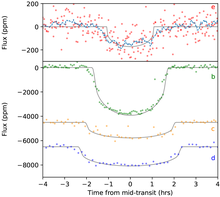K2-32
| Observation data Epoch J2000 Equinox J2000 | |
|---|---|
| Constellation | Ophiuchus[1] |
| Right ascension | 16h 49m 42.2602s[2] |
| Declination | −19° 32′ 34.151″[2] |
| Apparent magnitude (V) | 12.31±0.02[3] |
| Characteristics | |
| Spectral type | G9V[4] |
| Apparent magnitude (J) | 10.404±0.024[5] |
| Apparent magnitude (H) | 9.993±0.025[5] |
| Apparent magnitude (K) | 9.821±0.019[5] |
| Variable type | Planetary transit variable[6] |
| Astrometry | |
| Radial velocity (Rv) | −1.82±0.14[7] km/s |
| Proper motion (μ) | RA: −16.662(18)[2] mas/yr Dec.: −53.564(13)[2] mas/yr |
| Parallax (π) | 6.3939 ± 0.0153[2] mas |
| Distance | 510 ± 1 ly (156.4 ± 0.4 pc) |
| Details[3] | |
| Mass | 0.856±0.028 M☉ |
| Radius | 0.845+0.044 −0.035 R☉ |
| Surface gravity (log g) | 4.49±0.05 cgs |
| Temperature | 5275±60 K |
| Metallicity [Fe/H] | −0.02±0.04 dex |
| Rotational velocity (v sin i) | 0.7 km/s |
| Age | 7.9±4.5 Gyr |
| Other designations | |
| Database references | |
| SIMBAD | data |
K2-32 is a G9-type main sequence star slightly smaller and less massive than the sun.[4] Four confirmed transiting exoplanets are known to orbit this star.[9] A study of atmospheric escape from the planet K2-32b caused by high-energy stellar irradiation indicates that the star has always been a very slow rotator.[10]
Planetary system[]
Discovery[]
The star K2-32 was initially found to have three transiting planet candidates by Andrew Vanderburg and collaborators in 2016.[7] The innermost planet candidate, at that time, K2-32b was confirmed using radial velocity measurements made with the Keck telescope.[4] Confirmation of planets c and d was made by Sinukoff et al. using adaptive optics imaging and computer analysis to eliminate possible false positives.[6]
The Earth-sized planet K2-32e was discovered and validated by René Heller and team in 2019.[9][11]

Characteristics[]
With periods of 4.34, 8.99, 20.66 and 31.71 days the four planets orbits are very close to a 1:2:5:7 orbital resonance chain. The densities of planets b, c, and d are between those of Saturn and Neptune, which suggests large and massive atmospheres. The planet K2-32e with a radius almost identical to that of the Earth is almost certainly a terrestrial planet.[9] All four planets are well inside even the optimistic inner boundary of the habitable zone located at 0.58 astronomical units.[12]

| Companion (in order from star) |
Mass | Semimajor axis (AU) |
Orbital period (days) |
Eccentricity | Inclination | Radius |
|---|---|---|---|---|---|---|
| K2-32e | 2.1+1.3 −1.1 M |